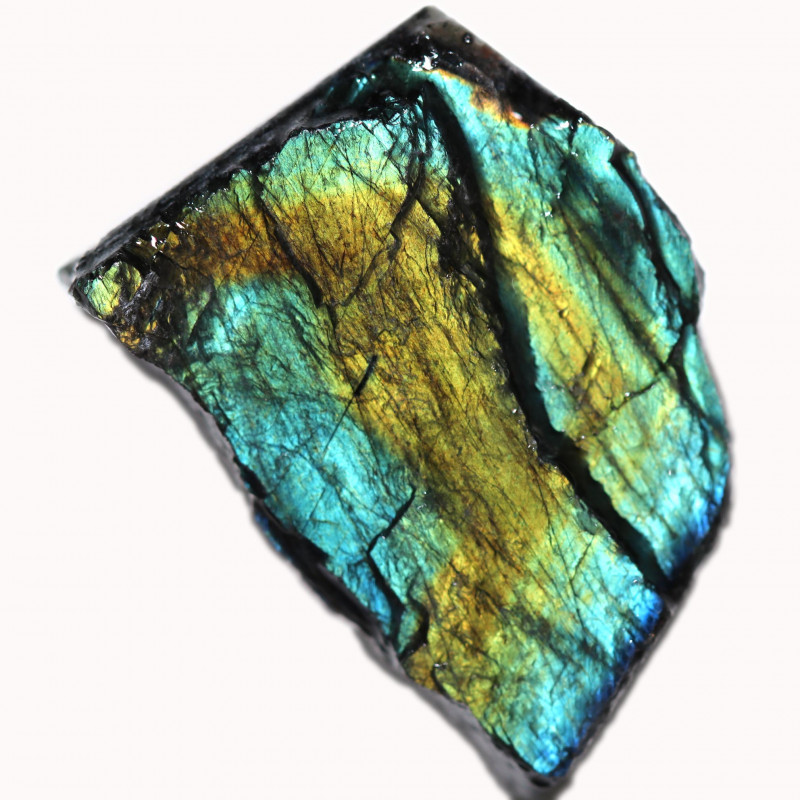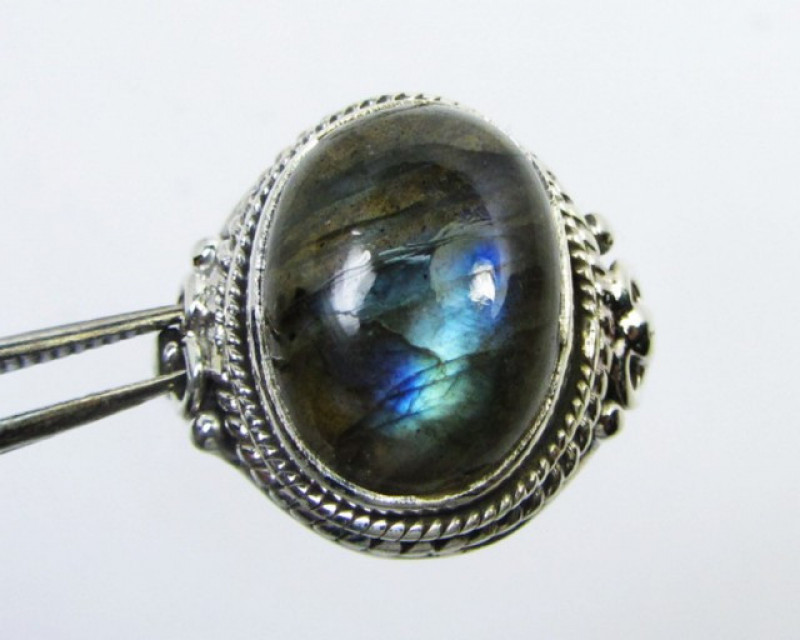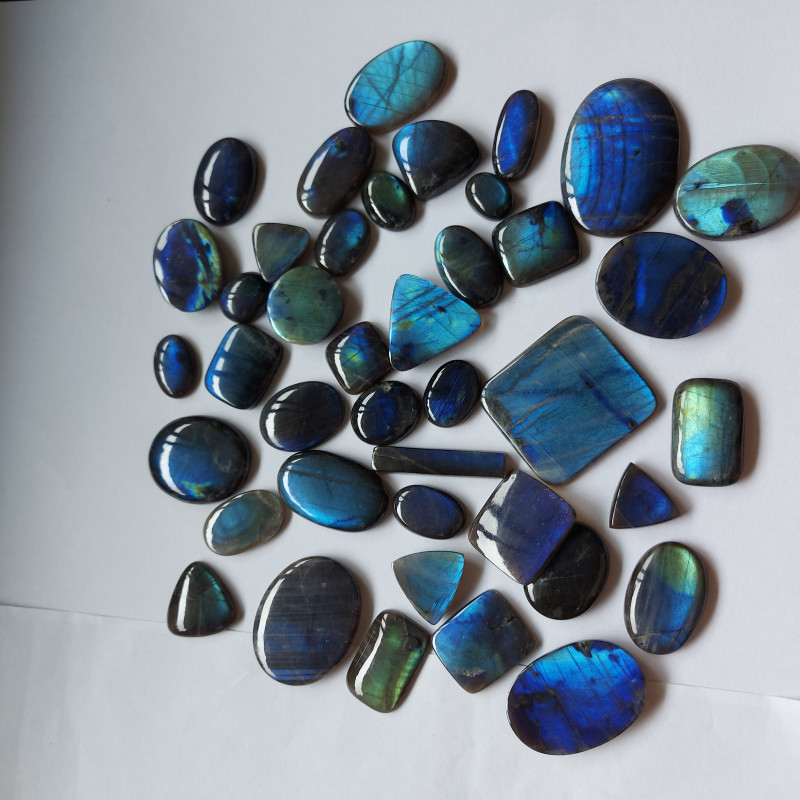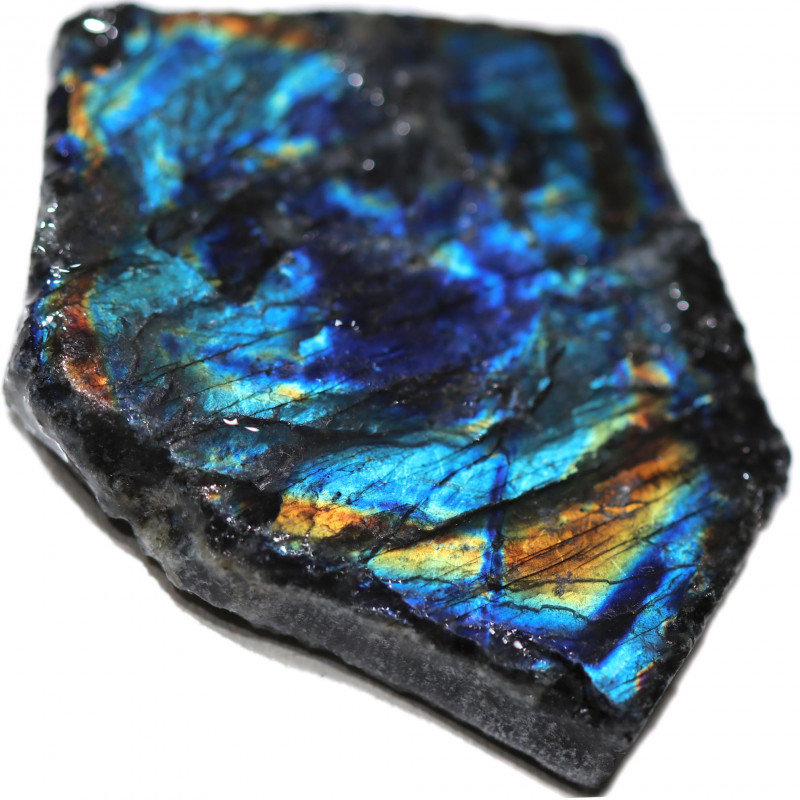
Spectrolite Gemstone: Properties, Meanings, Value & More
 Spectrolite is a rare, Finnish labradorite gemstone, set apart by its wide range of iridescent colors. Compared to other labradorites, spectrolite gemstones are generally higher-quality and only come from Finland.
Spectrolite is a rare, Finnish labradorite gemstone, set apart by its wide range of iridescent colors. Compared to other labradorites, spectrolite gemstones are generally higher-quality and only come from Finland.
But wait, what is labradorite?
Labradorite is a feldspar gemstone with a dark, translucent base naturally overlaid by a unique iridescence. The glow, or schiller, seems to come from inside the stone, and the phenomenon is named “labradorescence” after the gem.
So, what makes spectrolite labradorite so special? Today, we’ll answer just that, along with all your other questions about spectrolite’s properties, healing uses, and value.
Starting with the basics, what is spectrolite stone?

About Spectrolite Stone
First, is spectrolite a gemstone? Yes, spectrolite is a semi-precious gemstone with a dark base and strong, multi-colored iridescence.
The stone’s gemological name is spectrolite, but this term started as a brand name of Finnish spectrolite. While labradorite crystals from other locales may look similar to spectrolite, only specimens from Finland can legally be called “spectrolite.”
Many gem experts consider spectrolite the most beautiful type of labradorite. Given the stone’s full array of color flashes, we’d have to agree! Many folks draw parallels between spectrolite’s iridescence and other natural phenomena like rainbows and Aurora Borealis, also known as the Northern Lights.
While we’re discussing phenomena in the sky, it’s worth mentioning that spectrolite is a star stone for Uranus. It’s also a zodiac stone for Leo, Scorpio, and Sagittarius signs!

Spectrolite Specifications & Characteristics
Spectrolite and labradorite are feldspar stones, specifically anorthosite plagioclase feldspars. This means their composition is sodium, calcium, aluminum, and silicon. The calcium and sodium content can vary, with calcium between 50-70 percent and sodium between 30-50 percent.
Other plagioclase feldspars include sunstone and andesine. While these gems can show aventurescence (a metallic glittering surface), neither show the signature labradorescence specific to labradorite and spectrolite.
But what is labradorescence?
Labradorescence is a type of adularescence only used for labradorite stones. Adularescence is an iridescent play-of-color that appears to emerge from inside the stone, rather than on its surface. Moonstone is another gem with adularescence.
Spectrolite’s labradorescence occurs in part because of twinning, where multiple crystals grow into one another during the gem’s formation. The twinning crystals form alternating layers of two types of feldspars with different chemical compositions.
Given these factors, light hits the inside of the stone and then diffracts, separating into multiple rays. To our eyes, this separation looks like flashes of different colors.
Check out the rest of spectrolite’s mineral properties below:
Mineral family: Plagioclase feldspar
Mohs hardness: 6-6.5
Color: Black base; Full range of colors in iridescence
Crystal structure: Triclinic
Luster: Vitreous (glass-like) to pearly
Transparency: Mostly opaque
Refractive index: 1.56-1.57
Density: 2.65-2.75
Cleavage: Perfect on [001], Good on [010], Poor on [110]
Fracture: Uneven to conchoidal
Streak: White or colorless
Luminescence: Sometimes weak fluorescence; Red in SW-UV, bluish-white or violet-blue in LW-UV
Despite their similarities, spectrolite and labradorite are distinct gems. So, what is the difference between spectrolite and labradorite?
 Image: labradorite ring
Image: labradorite ring
Spectrolite vs. Labradorite
There are two main differences between spectrolite and labradorite: origin and appearance.
Origin
Labradorite’s discovery occurred in Labrador, Canada, while spectrolite was discovered in Finland over a century later. Labradorite stones come from many locales, but only spectrolite from Finland can legally be called “spectrolite.”
Appearance
Labradorite’s iridescence only shows grays, greens, blues, and sometimes purple flashes. Compared to labradorite, what does spectrolite look like? Spectrolite’s iridescent flashes can show every color of the rainbow.
The intensity of spectrolite’s labradorescence is also higher than labradorite because spectrolite’s opaque, darker base creates better contrast. That contrast also means spectrolite’s colors are separated more distinctly, while labradorite’s colors tend to blend into each other.
With the basics covered, it’s time to move into the mystical to examine the spectrolite labradorite meaning!
Spectrolite Meaning & History
Labradorite was first discovered in Canada in 1770, but spectrolite’s discovery wouldn’t happen until 1940 — more than 150 years later.
Renowned Finnish geologist, Aarne Laitakari, had described a particularly colorful labradorite specimen from Finland and spent years trying to find its source.
During WWII, Finnish soldiers were gathering stones to create a barricade against tanks, called the Salpa Line fortifications. One of those soldiers was Laitakari’s son, Pekka, who accidentally discovered a spectrolite deposit in Ylämaa among the barricade stones. Of course, Pekka told his father immediately.
Aarne Laitakari paid homage to the stone’s full iridescent display by choosing the name “spectrolite” after the Latin spectrum, meaning “image” or “appearance.”
Now, Laitakari wasn’t just a geologist — he was also the Director General of the Geological Survey of Finland from 1935 to 1960, among other various endeavors in military, political, and conservation work.
His widespread influence allowed him to spread awareness about spectrolite. Quarrying the stone began after the war ended and increased during the 1950s.
In 1973, the first Ylämaa workshop started creating and selling spectrolite jewelry from Finland. Soon after, the Ylämaa mayor established a gemstone center and an annual Gem and Mineral Show. In 1988, the Finnish Tourist Board named spectrolite as the official provincial stone of the South Karelia region.

Meaning & Mythology
The spectrolite crystal meaning is drenched in mysticism and folklore. Given that it’s native to Finland, the stone has Finnish mythology attached to it.
One myth associated with spectrolite is the “Story of the Rainbow Treasure.” The legend starts after Earth’s creation, as the god of thunder Ukko celebrates his wedding to the mother goddess, Rauni.
Rauni was melancholy that the Earth was mostly dark rock, so Ukko sent a giant (but brief) storm. Once the storm stopped, a rainbow appeared. Ukko grabbed the rainbow and cast it down to Earth, causing rainbow shards to remain melted into rocks. Those rocks, of course, are spectrolite!
Continuing the rainbow connection, some attach spectrolite’s meaning to the Bifrost Bridge, a rainbow gateway between Earth and the heavens in Norse mythology.
Outside of mythology, spectrolite symbolizes transformation, magic, and light. Sometimes called the “Stone of Mystical Wisdom,” spectrolite is rumored to improve the wearer’s spiritual awareness and intuition.
On that note, what is spectrolite crystal used for in healing circles?

Spectrolite Healing Properties
The colors and electrical energies inside gemstones can make them useful as healing crystals. Spectrolite is highly valued for spiritual and mystical uses, purported to enhance psychic abilities and awaken the aura.
Since its base is black, spectrolite joins other black gemstones in representing intelligence, protection, and fundamental truths.
What is spectrolite good for in physical, emotional, and chakra healing?
Physical Healing
Physical healing properties for spectrolite may include increasing energy levels, strengthening the body, and aiding metabolism. The stone is said to regulate breathing, digestion, and high blood pressure.
Other spectrolite crystal properties for physical wellbeing can include easing pain from arthritis, muscle soreness, and menstrual cycles. It’s said to soothe and relax the entire body.
Emotional Healing
Emotionally, spectrolite stone benefits anyone suffering from self-doubt or despondency. This mystical crystal can dispel anxiety, inspiring confidence and charisma in those who struggle to speak out.
Additionally, spectrolite gems are said to encourage originality, bring good luck, and reduce the negative effects of deep emotional wounds.
Chakra Healing
Chakra healing is an ancient practice involving opening or balancing your seven chakras, energy centers that align with physical and emotional symptoms. You can use gems as chakra stones to target issues related to a specific blocked chakra.
What chakra is spectrolite associated with? Spectrolite is great for opening the throat chakra — the center of communication, self-awareness, and truth.
Feeling disconnected from yourself or afraid of speaking your truth are signs of a blocked throat chakra. You can use spectrolite to open the chakra again, inviting creativity, openness, and self-expression back into your life.

Spectrolite Gemstone Properties
Gemstone experts examine certain properties in each stone to determine its objective value. Spectrolite’s value factors include color and cut.
Color (Labradorescence)
Unlike other gems, the color that influences spectrolite’s value isn’t present in the stone. Rather, the colors and intensity of spectrolite’s iridescence determine its value.
Since most labradorites will show cool tones like blue and green, maybe with some yellow mixed in, the rarer warm tones are highly desired. Any spectrolite where you can easily see every color in the rainbow shine from within will command the highest value.
The most dominant color flashes in spectrolite are green, yellow, blue, and purple. Brighter flashes mean higher value.
Cut
Like labradorite, the most common cut you’ll see is a spectrolite cabochon. Faceted cuts are rare, since spectrolite’s perfect cleavage makes faceting difficult.
Gem cutters may also cut spectrolite into beads or carvings. The most common spectrolite jewelry are bracelets, earrings, or pendants since a spectrolite ring has a greater risk of breakage.
Before it gets to a gem cutter, how does spectrolite form?

Spectrolite Formation & Sources
Spectrolite forms through a few methods, similarly to other feldspars. These methods include magma crystallizing, high-temperature/high-pressure, and sediment weathering.
During spectrolite’s formation, two feldspar minerals layer over each other: albite, a sodium aluminum silicate, and anorthite, a calcium aluminum silicate. These minerals alternate layers of tiny flakes in a process called lamellar twinning.
The most common spectrolite rock is a metamorphic or igneous rock, specifically basalt or gabbro rocks.
Mining Locations
As we mentioned earlier, the only stones that can legally be called “spectrolite” come from Finland. However, many sellers mistakenly call labradorites with a wider range of iridescence “spectrolite” when the stones aren’t from Finland.
Spectrolite is Finland’s most important gemstone export, but it’s still a rare stone. Given its rarity, what is spectrolite worth?
Spectrolite Price & Value
Each region’s spectrolite stone price may differ slightly based on availability. However, spectrolite will almost always command higher prices than labradorite.
Authentic Finnish spectrolite cabochons range from $20 to $200. Spectrolite jewelry is more valuable — usually costing $175 to upwards of $450, depending on the materials used. Spectrolite rough is the most affordable option, at $0.50-$2 per carat.

Spectrolite Care and Maintenance
Spectrolite’s hardness is mid-range, but combined with its perfect cleavage, it needs a little extra care. Pressure can chip or crack it, so we recommend opting for less vulnerable jewelry like pendants. You can also choose jewelry with protective settings for extra security.
To clean your spectrolite crystal, mix mild soap with lukewarm water. Dip a soft brush (like a toothbrush) in the solution, then gently scrub the stone. Rinse your spectrolite, then use a microfiber cloth to carefully pat it dry.
Store your spectrolite stones or jewelry away from other gems and avoid sudden temperature changes, as this could damage the stone.
Ride the Rainbow with Spectrolite!
Despite its rich history in Finland, you don’t have to be Finnish to appreciate the natural beauty and intrigue of spectrolite. It’s easy to get lost in this magical gem’s spectral colors, but the crystal’s ability to inspire your best will always bring you right back to where you need to be.
Want to wear the rainbow? Explore spectrolite for sale today!
Search the Gemstone Encyclopedia
Related Auctions
Related Articles
Originally the Birthstones or gemstones were associated with a zodiac sign or the month of a individuals birth. Find out what your stone is and view the stones we have for sale
8th Feb 2021
There are dozens of quartz and chalcedony gems with various colors and patterns. Learn all about quartz properties and every type of quartz, from amethyst and agate to plasma and phantom quartz!
15th Oct 2020
Hackmanite is a pink to violet sodalite gem known for its unique color-change and luminescence. Learn why hackmanite is special, from its rare qualities to the types of hackmanite jewelry available.
28th Mar 2018
Latest Articles
Yugawaralite is a rare colorless, white, or pinkish zeolite crystal named for its discovery in Yugawara, Japan. Here we uncover the multifaceted history, properties, prices, and uses of yugawaralite.
24th Mar 2025
Simpsonite is a lesser-known mineral known on the gem market for its durability, yellow-orange color, and rarity. Discover all the properties, uses, prices, and history of simpsonite.
3rd Mar 2025
Kurnakovite is a colorless crystal related to inderite and rarely faceted but known among collectors. Explore the mineral traits, history, prices, and more in this kurnakovite guide.
17th Feb 2025
Article Categories
How To's is where you will find helpful articles from gem Rock Auctions on how to cut gemstones, select gemstones and buy gemstones.
9 Articles





